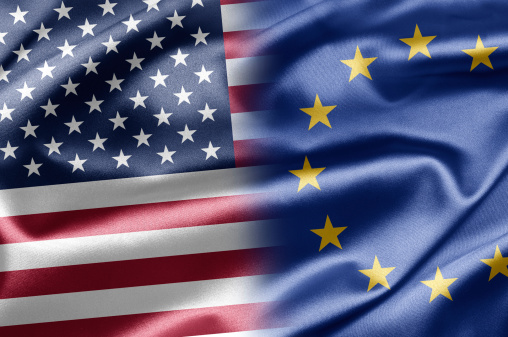
Trade talks could help improve regulatory policy in both the U.S. and EU.
In the 1980s and 1990s, following decades of advances in recombinant DNA technology, scientists began inserting foreign genes into food crops in order to confer beneficial properties such as disease-resistance and improved yield. Over the ensuing years, so-called genetically modified foods (“GM foods”) became increasingly common in U.S. agriculture, gradually displacing more traditional crops. Interestingly, across the Atlantic, GM foods met a starkly different fate, with the European Union (“EU”) requiring stringent scientific analysis of any “new foods” and erecting strict labeling requirements. In one sense, the disparate reaction to genetically engineered crops is not terribly surprising: European agriculture dates to time immemorial, whereas most U.S. farms were founded within the last two centuries and have relied on technological innovations from the very outset. Nevertheless, the contrast between Europe’s visceral aversion to so-called “Frankenfoods” and the comparatively muted American reaction (notwithstanding a recent creep of GM food labeling laws in a handful of states) is striking and largely disconnected from the scientific investigations of GM food safety (which have consistently failed to show any verifiable health risk).
The differences between European and American attitudes with respect to agricultural practices reflect a more fundamental issue: both public perceptions of risk and the process by which regulators go about enacting policies to combat those risks vary between the EU and the United States. At the same time, the comparable levels of economic development and consumer expectations on both sides of the Atlantic suggest that the EU and the United States share more similarities than differences. These commonalities present an opportunity to focus on how EU and U.S. regulators respond to common risks. In turn, this can lead to greater regulatory efficiency, which is why working to improve the compatibility of our regulatory systems will be a crucial component of the Transatlantic Trade and Investment Partnership (“TTIP”), an EU-U.S. free trade agreement currently under negotiation.
At a superficial level, the EU and U.S. approaches to risk analysis and regulation may seem fundamentally different. Commentators traditionally describe the EU regulatory system as “precautionary,” while characterizing the U.S. system as “risk-based” and driven by “cost-benefit analysis.” Like many stereotypes, this facile characterization does contain some underlying truth, but it papers over complexities of both systems and conceals numerous similarities. As an initial matter, neither a system based on a simplistic view of the “precautionary principle” nor a program based solely on quantified “cost-benefit analysis” is inherently viable. As Cass Sunstein has demonstrated, the “strong” version of the precautionary principle is internally unworkable: demanding virtual certainty of safety prior to allowing an activity can create far more grave countervailing risks and place a straightjacket on innovation or even basic enjoyment of life. For example, some isolated studies have shown a link between cellular telephone usage and certain types of brain tumors (although most other studies have found no such link), but no one on either side of the Atlantic seriously proposes banning all such devices until their safety is conclusively proven. Similarly, although efforts to base regulations on cost-benefit analysis are admirable and help ensure that regulators do not improperly overvalue certain goals at the expense of others, it is difficult to quantify certain regulatory “benefits,” such as environmental protection or psychological well-being, with any degree of precision.
Thus, the EU has rarely been absolutist in its adherence to the precautionary principle and applied a sort of de facto cost-benefit analysis, while U.S. regulations often reflect political decision making rather than hard analysis of the underlying science and economics. Indeed, Professor Jonathan Wiener has shown that U.S. regulations are more “precautionary” than their EU counterparts in a number of areas, including new drug approval, combating ozone depletion, particulate matter reduction, and limiting the risks of nuclear energy. Thus, the prevailing lexicon has the potential to create confusion, and bandying about terms such as “precautionary principle” and “risk-based regulation” is more likely to complicate rather than facilitate enhanced regulatory understanding and convergence.
Rather, any successful effort to identify systemic commonalities and opportunities for cooperation must return to first principles. In this light, it is critical to distinguish between matters of risk assessment and risk management. Risk assessment is the objective process by which scientists canvas existing knowledge and conduct analysis to determine what threat, if any, a particular thing or activity may pose. Risk management, by contrast, is the subjective process by which some decision-making entity (be it a legislature, a regulatory agency, or the sovereign people) determines what resources society ought to dedicate to abating or eliminating any risk identified in the risk assessment phase.
Unfortunately, the two inquiries are often highly conflated in practice. For instance, determining a “safe” concentration of arsenic in drinking water entails elements of both risk assessment (how many increased deaths does a particular concentration produce) and risk management (how much should governments spend to reduce deaths to an acceptable level). Regulators often fail to disentangle the two, leading to accusations of “politicization of science” (i.e., allowing political considerations to interfere with scientific integrity) and “scientization of policy” (i.e., concealing policy-based decisions behind a veneer of technical factfinding). Although it can be exceedingly difficult to affix either label to certain problems (e.g., is a confidence interval associated with a causative determination an issue of risk assessment or risk management?), many activities can be cleanly classified as one or the other.
The TTIP should focus initially on seeking greater cooperation related to risk assessment and only then seeking to develop institutions that will allow for greater coordination of risk management as regulators get to know each other and learn more about their respective decision-making processes. Even if the TTIP succeeds only in promoting enhanced international coordination in the field of risk assessment, it will represent an enormous improvement over the existing regime of balkanized regulatory scientific fact-finding. At present, regulators in both the EU and the United States conduct a number of duplicative tests, inspections, clinical trials, and other scientific processes. Negotiating mutual recognition agreements whereby U.S. regulators acknowledge scientific fact-finding by their EU counterparts (and vice versa), as well as a division of responsibility for future experiments, would conserve governmental resources at a time when regulators on both sides of the Atlantic are suffering from severe budgetary constraints.
Achieving enhanced coordination in the arena of risk management is both considerably more difficult and may even be undesirable in some contexts. Ultimately, a risk management decision reflects a determination concerning the amount of resources a society is willing to allocate to combating a given risk. Because such decisions are made either by legislators or executive branch regulators in modern democracies, they theoretically represent the policy preferences of the sovereign people. Thus, if the European people are willing to tolerate decreased agricultural productivity to avoid exposure to genetically modified foods, while the American people accept whatever health hazards, if any, such products may pose, then divergent risk management policies over food ought to be respected.
At the end of the day, nothing in the TTIP will change the ability of regulators in the United States and Europe to make independent risk management decisions. Certain cultural differences in public risk tolerances will invariably persist, and it would be counterproductive to force regulators to ignore those differences. In order to gain the necessary buy-in from regulators, the TTIP must preserve their final decision-making autonomy. However, over time, as regulators on both sides of the Atlantic become increasingly familiar and comfortable with each other’s respective scientific thinking, both risk management and risk analysis decisions and information are more likely to converge. In the end, this will result in a more efficient regulatory environment, leading to laws that aim both to remove trade irritants and enhance protection.
The opinions expressed in this blog post are solely those of the authors and do not represent the views of the Administrative Conference of the United States, George Mason University, or the U.S. Chamber of Commerce.





